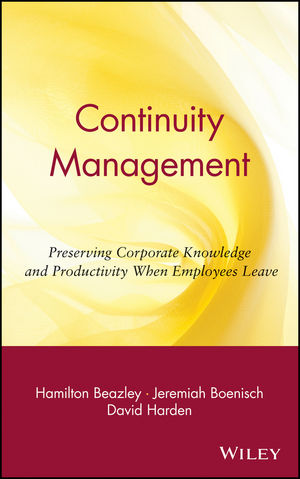Continuity Management: Preserving Corporate Knowledge and Productivity When Employees LeaveISBN: 978-0-471-21906-4
Hardcover
288 pages
August 2002
 This is a Print-on-Demand title. It will be printed specifically to fill your order. Please allow an additional 10-15 days delivery time. The book is not returnable.
|
||||||
Introduction.
PART 1: KNOWLEDGE CONTINUITY IN THE INFORMATION AGE.
1. Knowledge Loss in the Information Age.
2. Knowledge as a Capital Asset.
3. Knowledge Continuity: The New Management Function.
4. The Knowledge Learning Curve.
PART II: CONFESSIONS OF A CONTINUITY MANAGER.
5. Getting Started.
6. Six Steps to Continuity Management.
7. The Knowledge Continuity Assessment.
8. Designing the Knowledge Profile.
9. Developing K-PAQ: The Knowledge Profile Analysis Questions.
10. Developing K-Quest: The Knowledge Questionnaire.
11. Creating the Knowledge Profile.
PART III: KNOWLEDGE ASSET MANAGEMENT.
12. Operational Knowledge Transfer and Acquisition.
13. Realignment of the Organizational Culture and Reward System.
14. Continuity Management in Practice.
References.
Acknowledgments.
Index.
About the Authors.
PART 1: KNOWLEDGE CONTINUITY IN THE INFORMATION AGE.
1. Knowledge Loss in the Information Age.
2. Knowledge as a Capital Asset.
3. Knowledge Continuity: The New Management Function.
4. The Knowledge Learning Curve.
PART II: CONFESSIONS OF A CONTINUITY MANAGER.
5. Getting Started.
6. Six Steps to Continuity Management.
7. The Knowledge Continuity Assessment.
8. Designing the Knowledge Profile.
9. Developing K-PAQ: The Knowledge Profile Analysis Questions.
10. Developing K-Quest: The Knowledge Questionnaire.
11. Creating the Knowledge Profile.
PART III: KNOWLEDGE ASSET MANAGEMENT.
12. Operational Knowledge Transfer and Acquisition.
13. Realignment of the Organizational Culture and Reward System.
14. Continuity Management in Practice.
References.
Acknowledgments.
Index.
About the Authors.



